In the first part of these travel stories during which I visited Leskovac, south Serbia, and part of its surroundings, I mentioned the topic of an “ugly city.”
Even then, I said that I personally couldn’t, in good conscience, say that Leskovac is a beautiful city in the classical sense, but I’ve been there often enough, I have wonderful memories tied to this city, and some of the people I love most in this world still live there – so I absolutely cannot view Leskovac with objective eyes. The only thing that matters to me is that I love coming there.
On the other hand, different people see different things and assign importance to different elements – not just when it comes to the urban appearance of a place, but in general.
I believe I’ve had one huge piece of luck in life and that is learning one of the most important life lessons fairly early on.
Back in 1993, when hyperinflation was raging in the then Federal Republic of Yugoslavia (Serbia and Montenegro), one of the three worst in the world ever, I had the “fortune” of working for a company that sent me to Budapest on average twice a month for business. At the time, I stayed in five-star hotels and went to business lunches/dinners that, by the standards of my country back then, cost a small fortune. I also had the opportunity (and money) from per diems to shop in Hungarian supermarkets for food and laundry detergent, which I would then bring home, since the selection in Yugoslav stores was reduced to an unimaginably bare minimum. So, on the surface, everything seemed great, except that my boss was a total brute who yelled at everyone and humiliated the people who worked for him (myself included, of course), and I was often brought to tears and felt indescribably awful. No amount of luxury around me could improve my mood, bring a smile to my face, or lessen my sense of misery. (As it happened, by the end of 1993, I had resigned and stopped working in December, when the average monthly salary was 2 Deutsche Marks, equivalent to 1 euro later on.)
Around that same time, I was also regularly going hiking, most often in Montenegro, usually over the weekends, and we would sleep in katuns (seters), informal seasonal mountain settlement consisting of wooden huts used by families who graze their cattle there, which meant there was no electricity, while water was fetched from a nearby spring. The food was "from the backpack," meaning whatever we brought from home. And yet, the simplicity of those experiences was in complete contrast to the feeling of happiness, fulfilment and contentment I felt, and I usually couldn’t wipe the smile off my face.
The lesson from these two short stories is very simple: it doesn’t matter what surrounds us. What matters is what we experience inside and whether we are happy. I love to travel and I’ve been to objectively very beautiful places, seen exceptionally lovely, wealthy, well-kept cities, but I’ve also been to places that are dirty, neglected, and poor... I’m deliberately not naming the places I consider to fall into one category or the other. But I’m glad I’ve seen both and that I’ve had the opportunity to experience both. Was I happier in the “prettier” places? Oh, no! Was my sense of the beauty of existence tied to “beautiful” cities and landmarks alone? Oh, no!
To be honest, the most intense feeling of happiness sparked by what I see usually happens when I’m in nature, untouched by human hands. But I’ve also realised that when I travel through poorer and less “orderly” places, I don’t view them through that lens at all, I simply enjoy the experience for what it is. Without comparisons. Without rankings.
And that brings me to my story about Leskovac. Whether it is a visually attractive city or not is completely irrelevant. What matters is how a visitor or a resident perceives it or comes to perceive it.
Besides that, a settlement isn’t made up only of buildings – it’s primarily made up of the people who live there. And it also matters what you’re comparing something to. My impression is that we Serbs are excessively critical of things in our own country and we’re especially prone to (unrealistically) comparing ourselves to wealthier countries, usually in Western Europe. I also think that people often equate beauty with wealth that admittedly usually results in a high level of orderliness in a town or city, but on the other hand, says a lot about the insecurities of those making that kind of comparison.
In other words, this is where the saying “The grass is always greener on the other side” comes into play – or, as people from Leskovac would put it much more vividly: U tuđega tatka pogolema patka (“someone else’s daddy has a bigger duck” – a literal translation, but “duck” in slang can have another meaning).
And this brings me to one very important aspect of Leskovac: its residents and their exceptional charm and quick wit.
The whole south of Serbia – Niš, Vranje, Pirot, Leskovac, and the surrounding areas (apologies to anyone I haven’t specifically mentioned) uses a dialect in everyday speech that includes not only specific vocabulary and a very interesting approach to grammar (e.g., fewer grammar cases), but also an accent that the rest of the country finds extremely endearing and (positively) funny. But even more importantly, the people of Leskovac (and I believe the same goes for folks from Niš, Vranje, Pirot, and others) genuinely enjoy their way of speaking and are happy to joke about it, and about themselves. And that kind of spirit is something of immeasurable value.
Thus, while walking through the centre of Leskovac, I came upon a cultural monument of great significance – the Šop Đokić House. But before I get into that, just a quick connection to what I previously mentioned. After finishing my visit to the house, I chatted a bit with a couple of people sitting in front of it, apparently working as security there. At the end of our conversation, I told them I was going to go “promaem” (walk idly around) a bit and they “iscepaše se od smejanje“ (burst out laughing). As someone with roots in Leskovac and a linguist, I love using local expressions like that and they always bring smiles to everyone involved in the conversation. (Needless to say, these nuances simply cannot be translated well into any foreign language, but just be aware that these are expressions that are often not understood even by native speakers of Serbian who are not familiar with this dialect.)
And now, let’s focus on the immovable cultural heritage site of great significance located right in the centre of Leskovac. We’re talking about the Šop Đokić House. This building was constructed in the early 19th century.
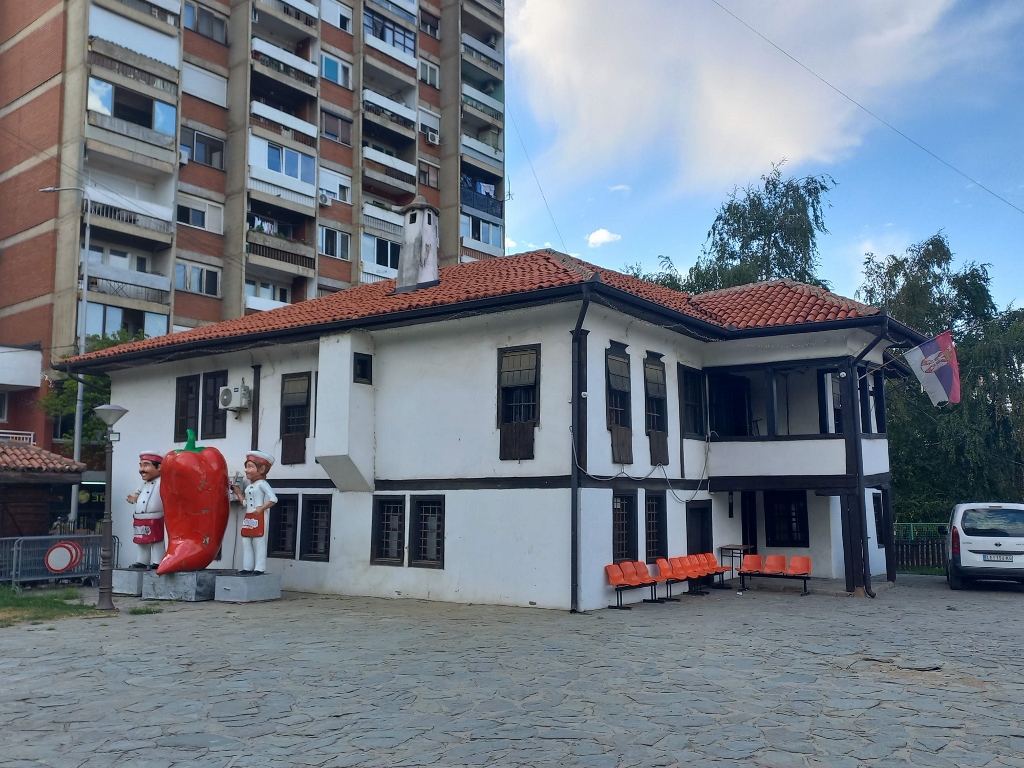 Šop Đokić House
Šop Đokić House
Today, the Šop Đokić House is home to the Leskovac Tourist Organisation and in the previous photo, on the left side, you can see a “sculpture” symbolising two things Leskovac is perhaps best known for – peppers and grilled meat (the grill is represented by two chef figures). Every year, at the end of August and beginning of September, a true festival of grilled meat is held – Roštiljijada. During the event, the main boulevard is closed to traffic, while the entire city smells of barbeque (skara) and grilled delicacies. It’s a very popular event that brings many visitors to Leskovac.
In addition to grilled meat, peppers of all kinds is another key product of this part of Serbia, including hot peppers that are often mixed into the meat for grilling, creating a wonderful combination (assuming you're not a vegetarian and that you enjoy spicy food). But peppers are also used on their own or in many other dishes, whether sweet or hot; they are processed, dried, pickled, turned into special meals, combined with other vegetables, and so on. On the topic of peppers, I once heard a funny line, of course delivered in a strong Leskovac accent: “Kod nas u Leskovac, kako paprike dođev, mi si ič suv lebac ne jedemo”, meaning, “Once the peppers come into season, we in Leskovac stop eating dry bread alone.” Oh yes, the spirit of Leskovac people is truly exceptional!
And now, finally, back to the story of the Šop Đokić House. The Šop Đokić family lived there from 1820 until 1956, when the house was partially confiscated and eventually nationalised. The building was constructed using the bondruk structural system (a timber-frame technique), and its multi-pitched roof with pronounced eaves is covered with ćeramida (a type of traditional roof tile). The house has a ground floor and an upper floor, and one of its most striking features is the divanhana (an open sitting area) on the upper floor, which faces the courtyard.
From the outside, particularly interesting are the shutters on the windows, where the top half lifts upwards and the bottom half folds downwards.
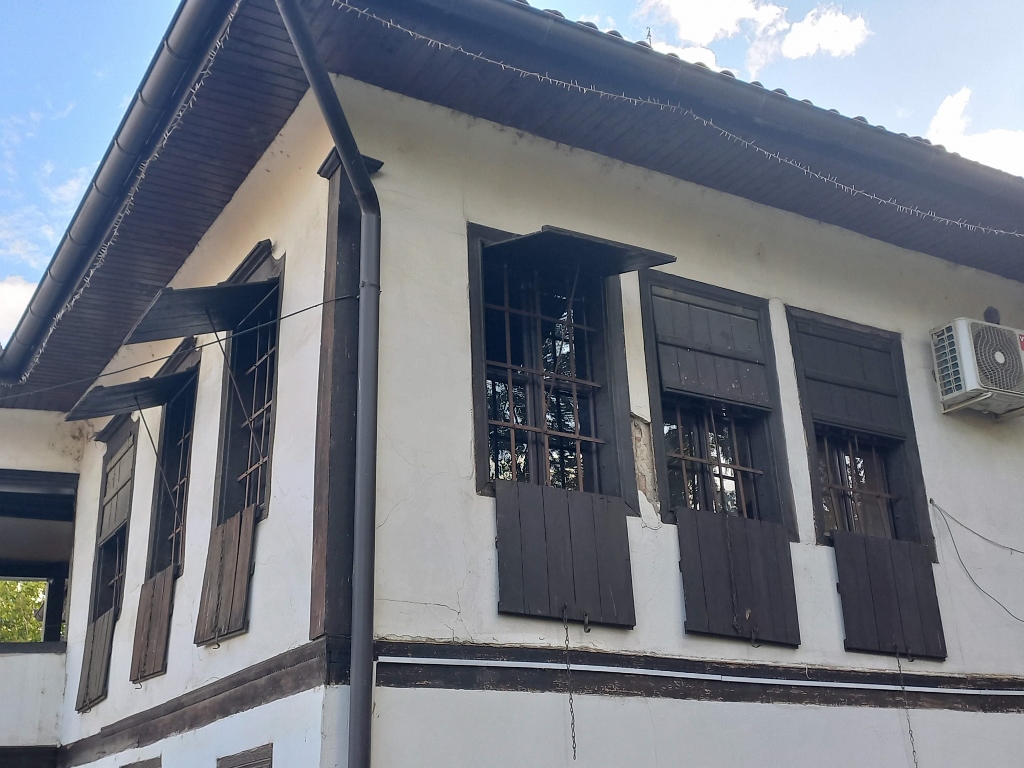 Šop Đokić House, a detail
Šop Đokić House, a detail
When I arrived, the working hours of the tourist organisation had already ended, so there were no staff members present, but the door was open and I peeked inside. It turned out there was a man there, presumably security, and when I told him I was visiting cultural landmarks in the city, he gave me a tour of the house and even handed me a couple of tourist brochures. I’m very grateful to him.
We immediately went upstairs via the wooden staircase, and here visitors need to be careful, as the steps are not all of the same height.
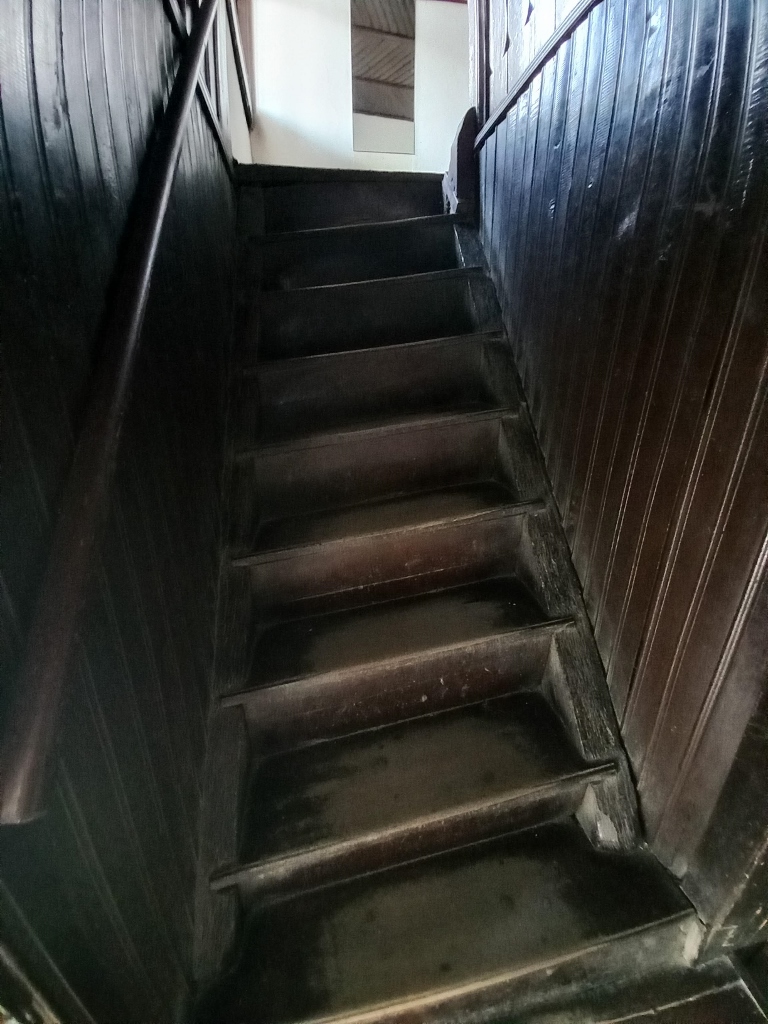 Šop Đokić House, a detail
Šop Đokić House, a detail
Upstairs, there are offices, but the most impressive feature is the divanhana (former sitting area) and its original ceiling.
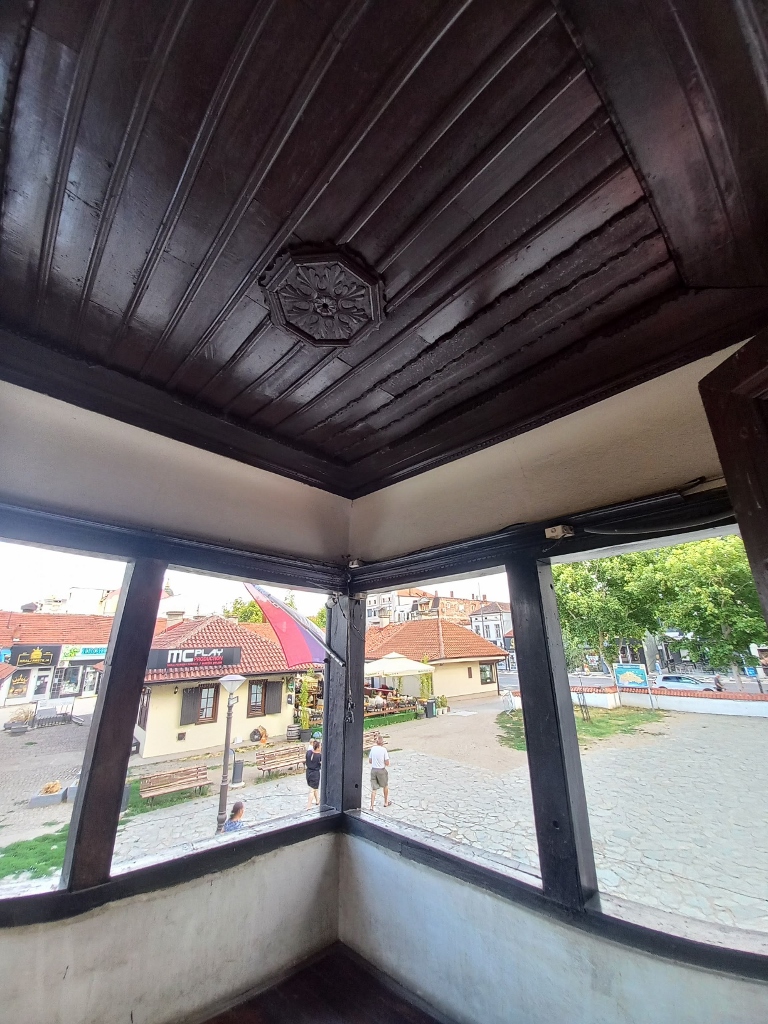 Šop Đokić House, a detail
Šop Đokić House, a detail
The rest of the house is also interesting and very beautiful, and I was especially fond of the door frames.
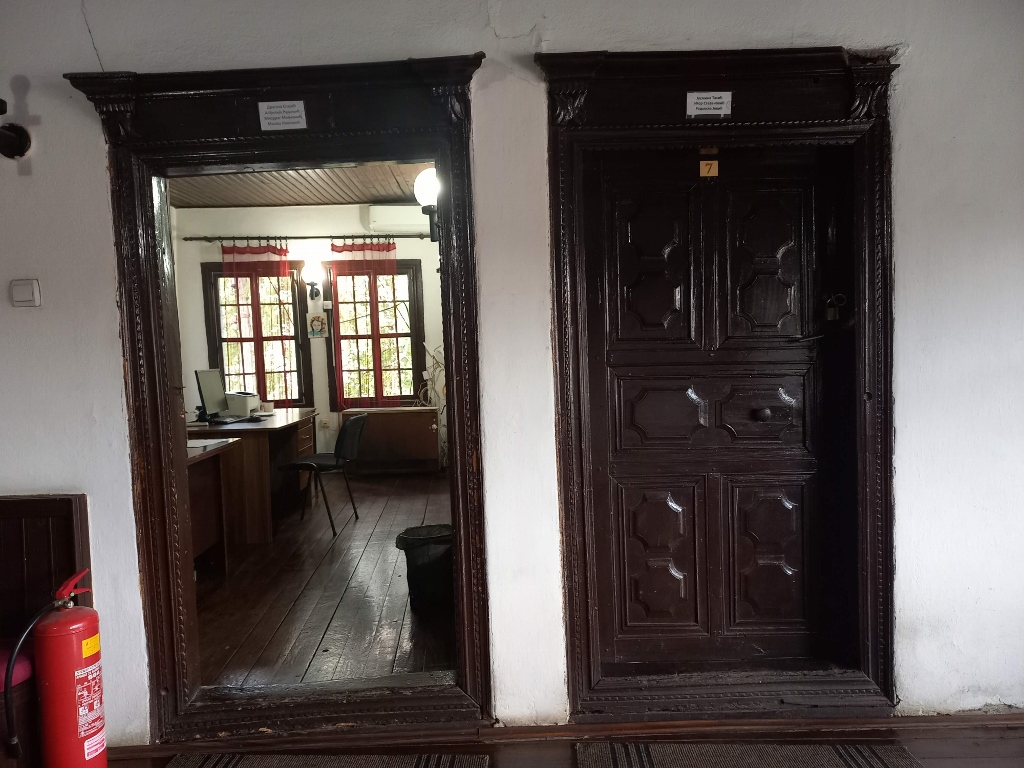 Šop Đokić House, a detail
Šop Đokić House, a detail
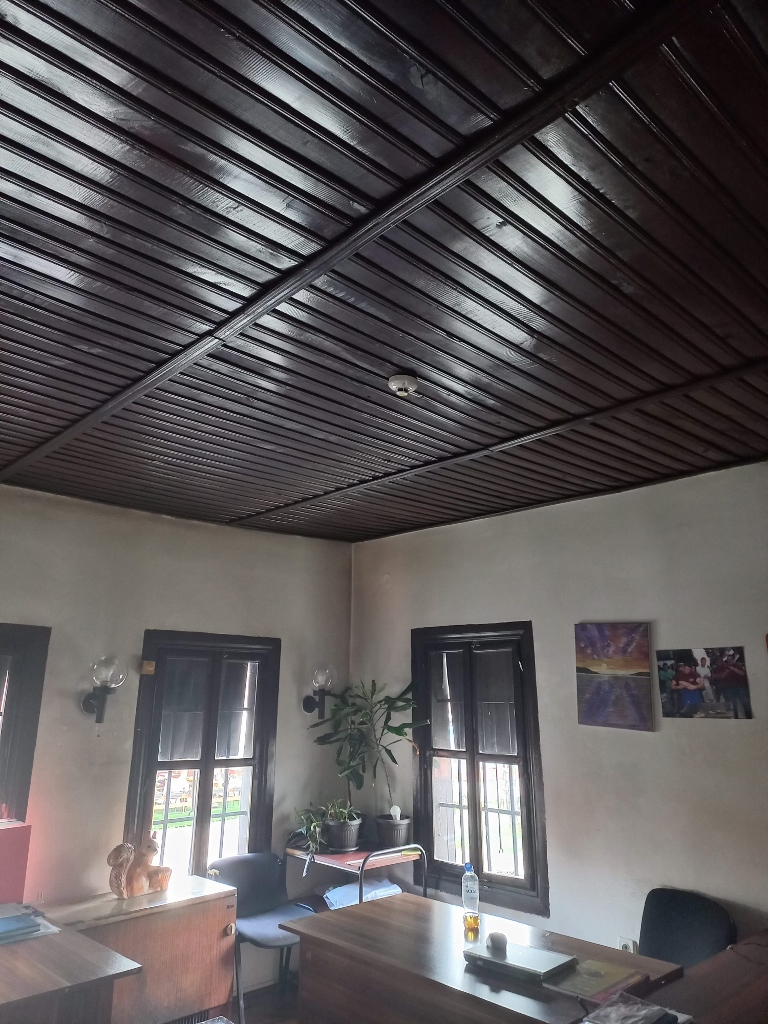 Šop Đokić House, a detail
Šop Đokić House, a detail
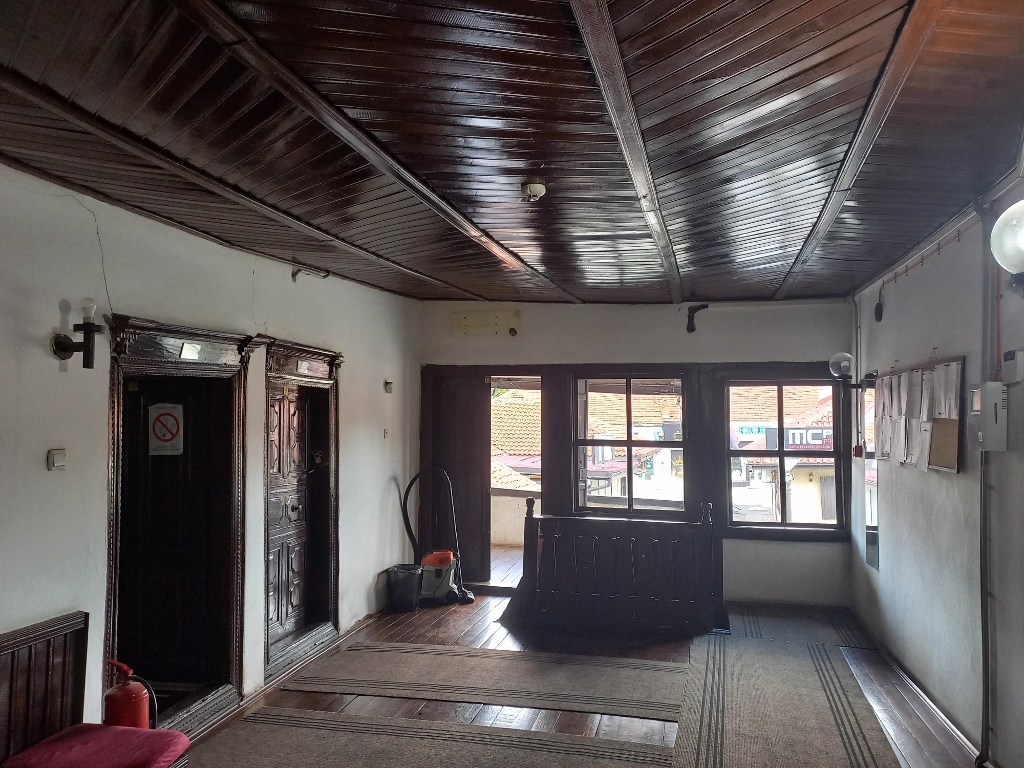 Šop Đokić House, a detail
Šop Đokić House, a detail
After visiting the Šop Đokić House, I went down into the courtyard and had a bit of a "utepuvanje" moment with a couple of the security staff. Here’s another colourful expression, closely related to another one – I could’ve also said "zacepuvanje." While there may be slight nuances in meaning, I use both when I want to say that I’m “wasting time talking or doing something, not necessarily in a bad way; on the contrary, it’s usually fun.” It’s easier when a single word can describe something that would otherwise take a couple of lines to explain.
But now, quite seriously, no utepuvanje or zacepuvanje, I continue with the story and my walk through Leskovac. In the city centre, there’s another old building, constructed in 1850, the Bora Dimitrijević-Piksla House that today houses a museum – Gradska kuća ("City House").
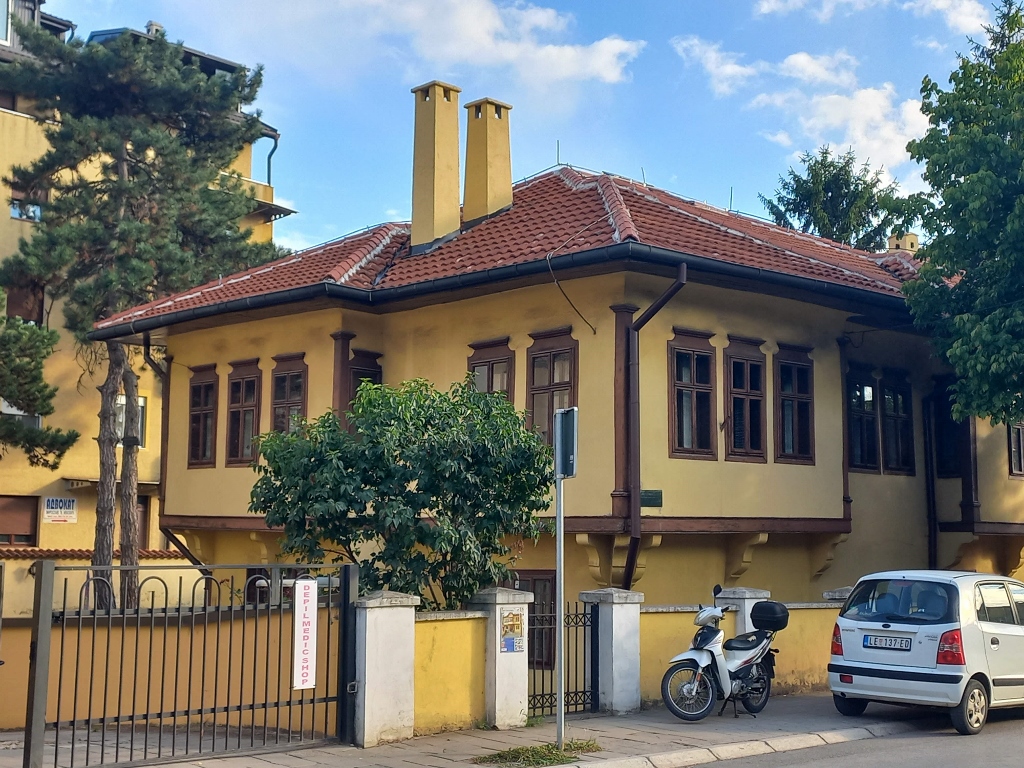 Bora Dimitrijević-Piksla House
Bora Dimitrijević-Piksla House
However, the museum was closed, as it was late in the afternoon, so I postponed my visit for another day.
Not far from there is one of the many urban houses listed as cultural monuments in Leskovac, classified as immovable cultural heritage. These urban homes, built between the two World Wars, primarily illustrate the rise of the urban class in a city where various branches of industry were rapidly developing, despite the fact that the region itself is predominantly agricultural.
After seeing most of the urban houses on the official list of cultural monuments, I was left wondering why some of them were granted the status of cultural heritage, while others I saw around the city, built in the same period, were not.
Also, the condition of these houses varies greatly, some are beautifully restored, others are maintained at a basic functional level, while some, I’d say, are in a state of decay.
And so I’ll start with one just like that, an Urban House at Dositeja Obradovića 29, directly across from the Leskovac Fair Hall.
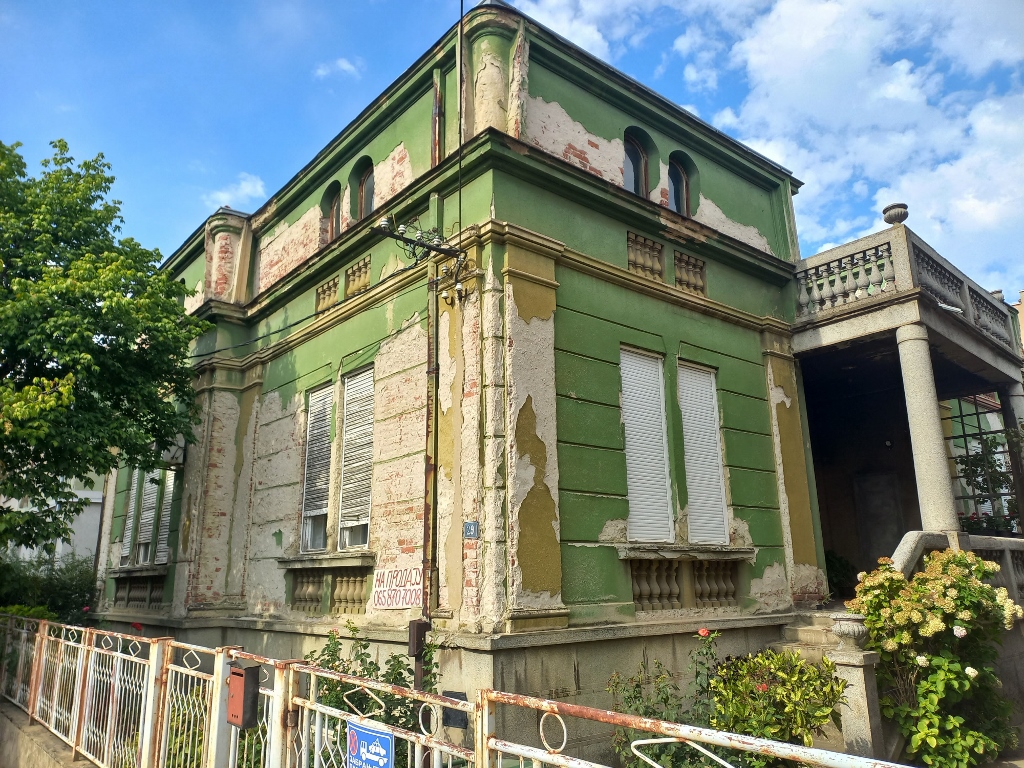 Urban House at Dositeja Obradovića 29
Urban House at Dositeja Obradovića 29
The house was built in the late 1920s as a family home for a prominent merchant from Leskovac. It consists of a basement, ground floor and attic. The materials I consulted mention the interior rooms and highlight the exterior decoration, but when I visited, all I could see was that the house appeared extremely dilapidated. To be fair, there was also a sign on the house indicating that the property was for sale.
When seen from the direction of the fairground, the relatively narrow lot on which the house stands prevents a full view of the structure. In reality, it’s quite a large house, and I realised this by chance while walking along a neighbouring street, where there's an empty lot, without any buildings, over which parts of the house I’m talking about could be clearly seen.
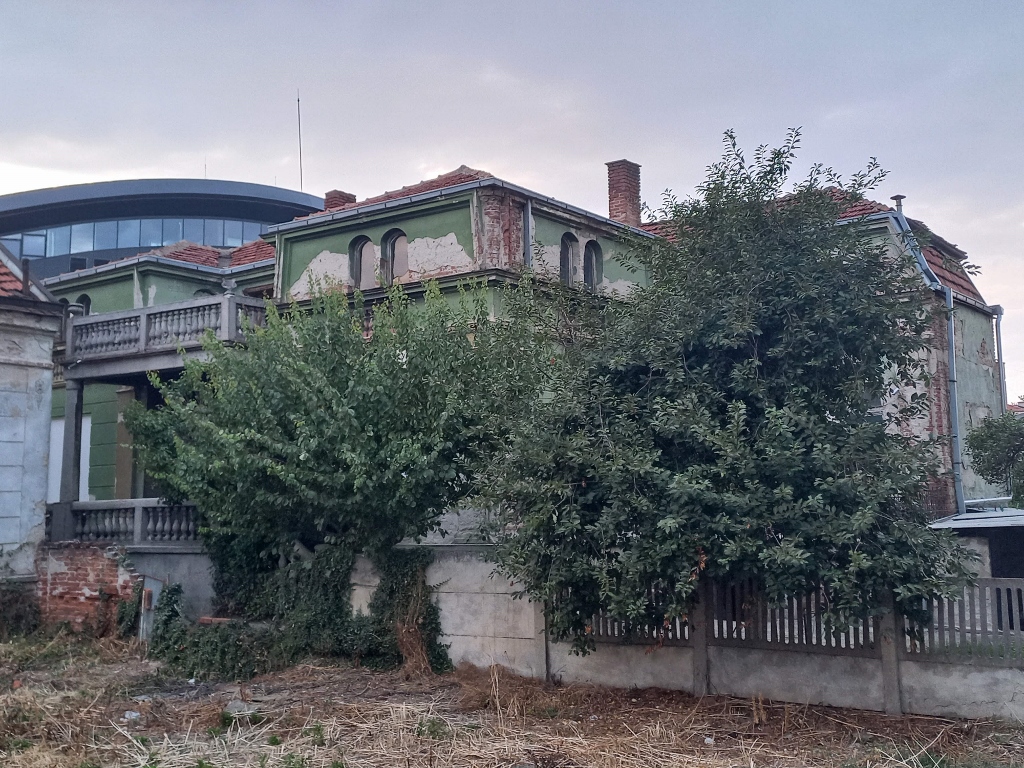 Urban House at Dositeja Obradovića 29
Urban House at Dositeja Obradovića 29
When cultural heritage houses are in poor condition, this often presents quite a serious problem. In most cases, they no longer belong to the original owners. After World War II, homes of wealthy individuals were frequently confiscated or repurposed for new tenants, and ownership was lost. Even if the original owners remained in the house, due to changes in the socio-economic system, they no longer had large factories, businesses or similar sources of income to support them, so all of this led to significantly reduced or nonexistent maintenance of such properties, something the new tenants were generally not even interested in. In other words, these houses, now nearly a hundred years old, began to visibly deteriorate, both in appearance and overall condition.
On the other hand, if such a house is declared a cultural monument, then, at least according to the law, alterations, repairs or extensions cannot be made at will. Special permits must be obtained and this process is often slow and demanding for various reasons. As far as I know, there's a strict insistence on using original materials, preserving the building’s original appearance and similar requirements, while all of that usually comes at a high cost. Owners would probably find it easier, and even cheaper, to demolish the old house and build a completely new one using modern materials and in a contemporary style that suits their taste better.
I have already, admittedly rather strictly, commented on this kind of issue in the case of a house in Kragujevac (see: https://www.svudapodji.com/en/kragujevac-3/).
Although I can fully understand the challenges faced by people who, through one circumstance or another, live in these types of houses, I have a soft spot for cultural monuments in my country and I’d prefer to see all of them in excellent condition. For now, that’s certainly not possible, and I’m not even sure what the right way to solve these issues would be. Perhaps some form of public-private partnership? I don’t know.
Just about a hundred metres further on, there’s another house that I believe is classified as a cultural monument, under the name “Building at Lole Ribara 66.” The reason I’m not entirely sure is that there is no longer a street called Lole Ribara in Leskovac. On the map of the Institute for the Protection of Cultural Monuments of the Republic of Serbia, this house is marked at a location the current address of which is Mlinska 66. It’s the house shown in the following photo and it matches the description I had. It is almost certain that this is indeed the house in question, which now has a different address, but is still listed in the records under the old street name.
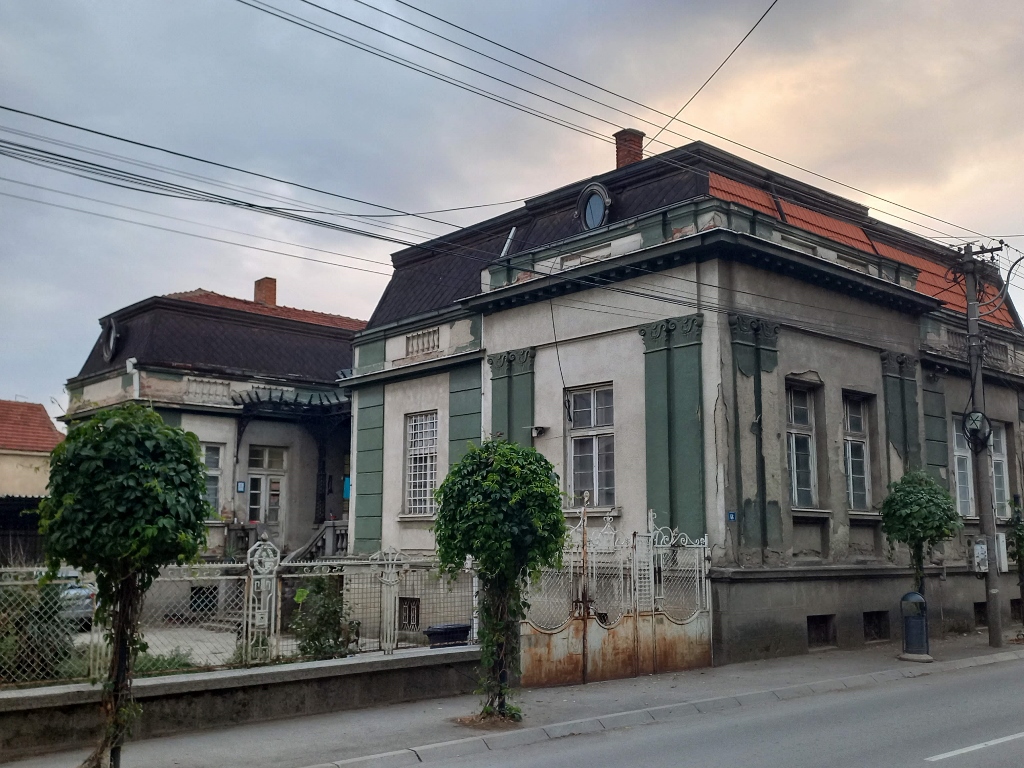 Building at Lole Ribara 66
Building at Lole Ribara 66
This is a large building constructed in 1936 as the family home of yet another merchant from Leskovac. It consists of a basement, a raised ground floor and an attic in the form of a mansard roof. The building was built with particular grandeur, featuring a monumental staircase and an entrance terrace, as the house is accessed from the courtyard. Although I didn’t get close, I could clearly see the decorative details on that staircase, which include elements of Art Nouveau.
On the same street, Mlinska, but at number 42, there is also the Building of the Information Organisation “Naša Reč.” The house was built between 1925 and 1930, and once belonged to the wealthy Vlajčić family (already mentioned in a previous part of the travelogue about my visit to Leskovac). It is a house with a basement and a raised ground floor, and it is accessed from the courtyard via a staircase with a porch.
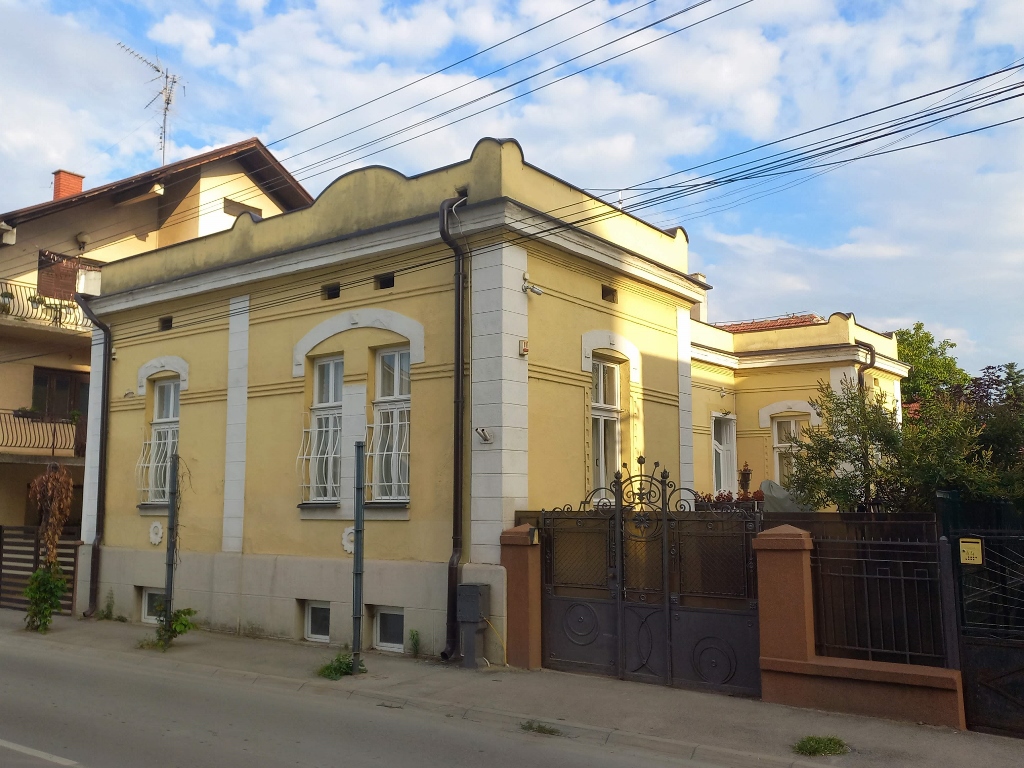 Information Organisation „Naša Reč“ Building
Information Organisation „Naša Reč“ Building
Although the name of the house can be confusing at first glance, over time I understood that cultural monuments are recorded under the name they were originally registered with during the categorisation. Thus, this house was originally owned by the Vlajčić family, but after World War II it was confiscated and then used as the editorial office of the newspaper Naša reč (hence the name) and for the needs of the Leskovac radio station. Over time, the function of the house changed and since 2015 it has been used as a safe house for victims of domestic violence.
Further along Mlinska Street, at the corner with Pana Đukića Street, there is another cultural monument – the District Court Building in Leskovac, nowadays the High Court.
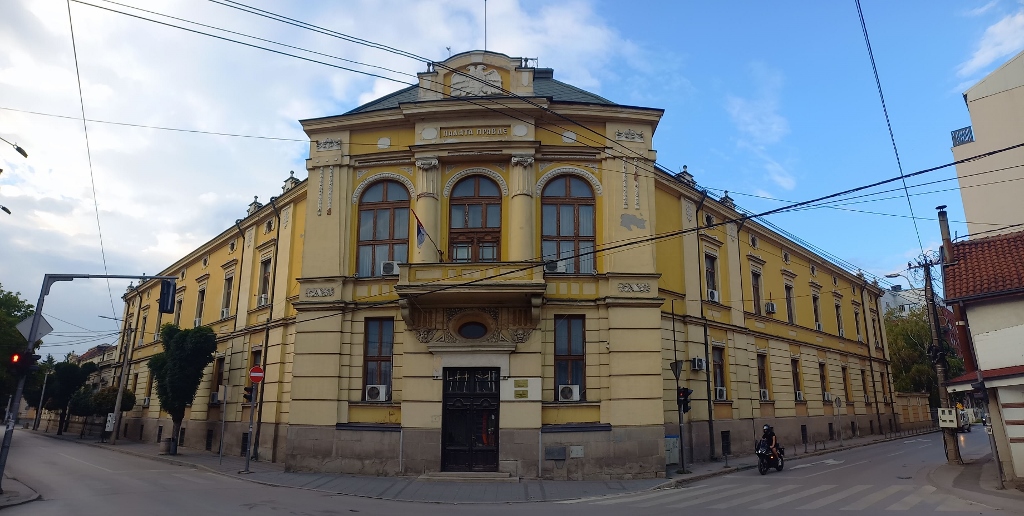 District Court Building in Leskovac
District Court Building in Leskovac
This is a representative two-storey building constructed between 1906 and 1908, but it suffered significant damage during the Allied bombing in 1944. However, key elements have been preserved, and the building soon after regained its function. I do not know what the interior looks like, but the corner facade is especially beautiful.
Continuing north along Pana Đukića Street, at the very next intersection, there is another representative building on the corner of two streets, which today houses the seat of the Jablanica Administrative District. The building was erected at the beginning of the 20th century and, like the current High Court, it is positioned in such a way that it follows the lines of two streets, with its corner cut, where the entrance is located. Its facades are somewhat more modestly decorated and the building is only one storey. However, it is not categorised as a cultural monument because of its architectural features, but because of its association with the Communist Party (which was in power in Yugoslavia after World War II, when the categorisation of immovable cultural properties occurred). Thus, the building is registered as the Building where the seat of the first Communist municipality was – the headquarters of the Municipality of Leskovac.
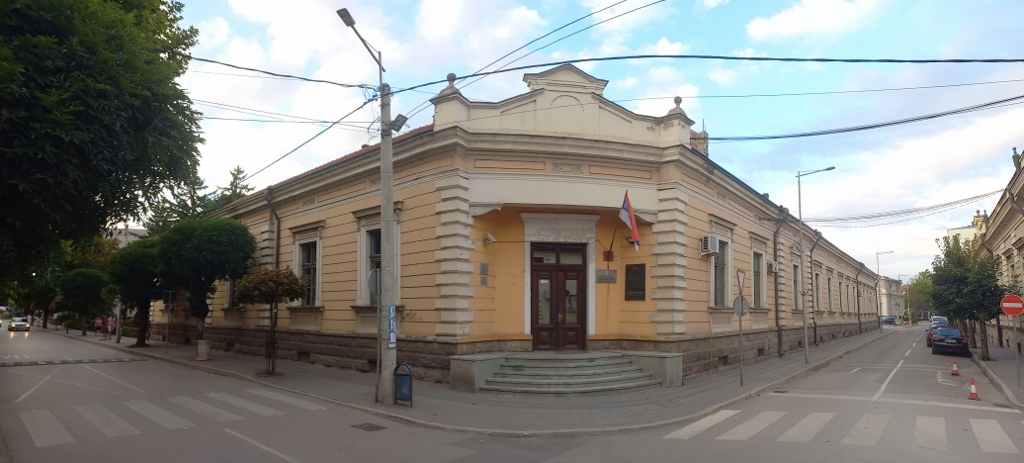 Building where the seat of the first Communist municipality was – HQ of the Municipality of Leskovac
Building where the seat of the first Communist municipality was – HQ of the Municipality of Leskovac
However, this whole story should not be dismissed due to ideological prejudice, because it is actually very interesting. Namely, on 22 August, 1920, municipal elections were held in the then Kingdom of Serbs, Croats and Slovenes (later Yugoslavia), and the Communist Party of Yugoslavia (founded in 1919) won in Leskovac. This was quite unexpected, considering that the southern part of the country was regarded as more conservative. However, all that industrial development in Leskovac meant that there were many workers here and many of them were politically active. All in all, the municipal government was taken over by the Communist Party after, I would say, democratic elections, but this led to panic in the capital due to fears of the spread of communist influence and ideology. Ultimately, by 1921, the activities of the Communist Party of Yugoslavia were banned (in a highly undemocratic manner) throughout the country, including in Leskovac, and its members were persecuted and arrested, and of course they were not allowed to participate in political life.
So, this is a brief reminder of a part of the history of democracy in Serbia.